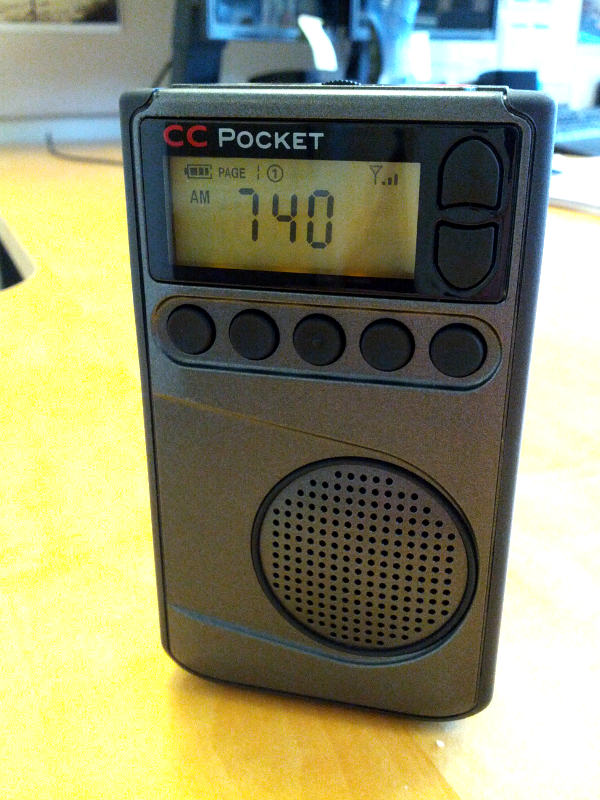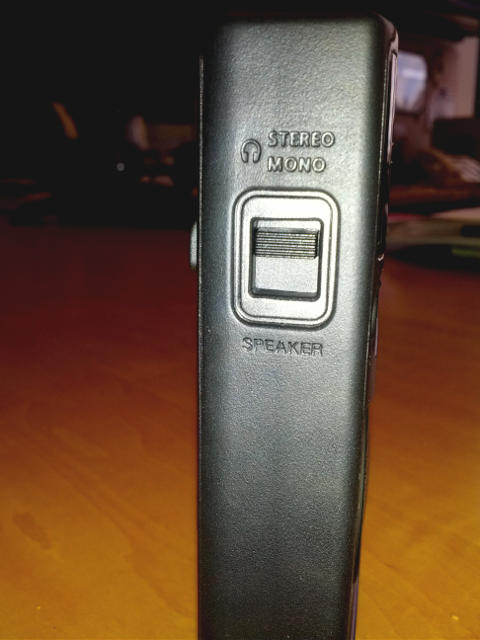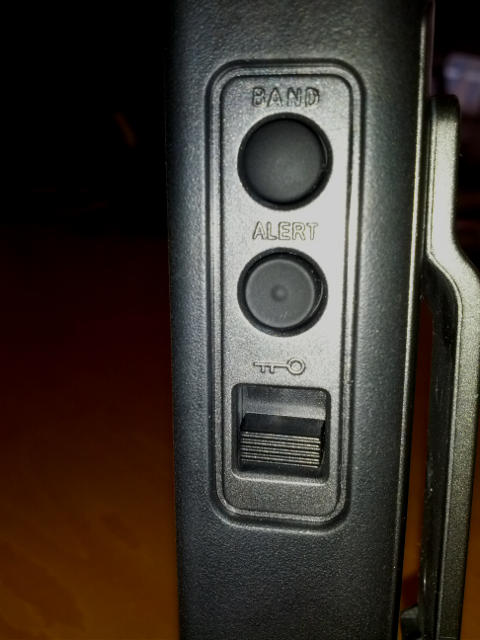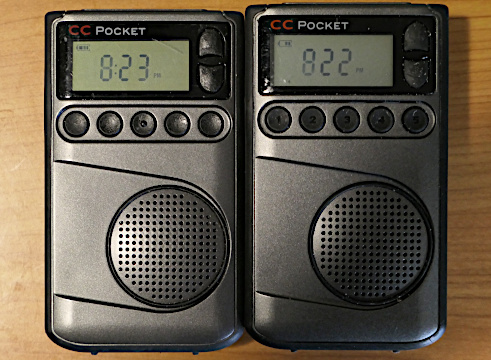
It's definitely not your old transistor radio, though it's about the size of the AM-only pocket radios that the Baby Boomers grew up with. (That includes me and my Zenith Royal 40, thank you very much.)
It's pocket-sized, if you have a big pocket: 2.5 inches wide, 4.25 inches high, 0.9 inches deep. The color is a dark gray with black buttons. Most of the buttons and the sides and bottom of the unit are rubberized. It can stand up easily. The front speaker is an inch and a half in diameter, so you're not going to get hi-fi sound out of the speaker.
The buttons in the front serve multiple purposes. When the radio is on, they function as presets. In addition, button number 1, in combination with other buttons, can perform certain functions:
- Buttons 1+3 - select AM audio bandwidth, either 4 kHz or 2.5 kHz
- Buttons 1+4 - permit AM tuning in 1 kHz steps rather than 9 or 10 kHz steps
- Buttons 1+5 - turn off the display for better AM reception; holding 1+5 down will restore the radio's settings to factory defaults
When the radio is off, button 1 sets the clock, 2 sets the alarm, 3 turns off the audible beep when button are pressed, button 5 switches between 9 and 10 kHz AM spacing. Unfortunately, if 9 kHz spacing is chosen, the tunable frequency range for FM is also changed, to 76 to 108 MHz. This may be inconvenient for almost everyone outside North or South America. It's really only good for Japan, where FM stations are found from 76 to 90 MHz, and even then there's still a lot of empty space to be tuned.
Button 4 toggles the default display, when the radio's on, between displaying the time and displaying the frequency of the station to which the radio is tuned. There's a handy reminder sticker on the back of the door of the battery compartment for these functions. The radio requires two "AA" batteries; there's no external power jack.


The left side has a speaker-stereo-mono switch, which along with an analog volume control on the top, strongly hints at commonalities with Sangean pocket radios. There are reports that Sangean is the manufacturer of this unit.
The switch allows use of the speaker along with a separate wire, not included, to serve as the FM antenna. There are built-in AM and FM/weather band antennas; the built-in FM antenna is not very effective, though it seems to perform acceptably for weather-band stations. The switch also allows stereo FM reception (through headphones) to be switched on and off. Weak stereo FM signals can be far noisier than mono, so this is a good feature to have to listen to lower-powered or more distant FM stations. Stereo reception is not a factor on the other two bands, of course.
On the right side, there's a button to toggle among the AM, FM, and weather bands, and another button that turns on an alerting feature. When this is on, the radio tunes only the weather band. It will then listen for an alert tone from the National Weather Service station that precedes severe weather warnings. The alert feature can be activated for 4 hours, 8 hours, or 16 hours. Finally, there's a lock switch, another indication of Sangean heritage, to keep buttons and switches from working.
When the band-selection button is pressed and held down, it's used to select additional memory presets. The radio supports up to 5 banks of 5 presets each. I haven't fully explored how this works, but apparently the presets are band-specific, yielding a total of 50 possible presets.
On the top surface, not shown, is a single stereo headphone jack, an analog volume control, and a red on/off button.
In 2012, I decided to compare the radio's performance with three Tecsun DSP-based radios, as well as with the then-current version of the Sangean DT-400W AM/FM/weather radio. Note that the DT-400W has since been issued in an improved version, so these results aren't applicable to present-day DT-400W models.
Here are the highlights.
AM reception
For this part of the test, I compared only the CC Pocket and the Sangean. I had categorized the Sangean's AM performance as good. I ran this test shortly after noon in order to ensure the minimum amount of propagation, especially for stations in the upper part of the AM band. How did the CC Pocket compare? My metric was simple: the number of stations received at my then-location in the San Francisco Bay Area:
- CC Pocket: 49 with 4 kHz bandwidth; 53 with 2.5 kHz bandwidth
- Sangean DT-400W: 51
It's a very respectable performance on the part of either radio. The CC Pocket seemed to be slightly more sensitive at the extremes of its 520-1710 kHz reception range. The additional four stations received when using a narrow reception bandwidth were quite weak, but they were audible. Turning the display off wasn't much of a factor except for one station. Both radios also picked up a pesky false signal at 760 kHz, caused by the proximity of two local 50 kW stations at 810 and 860. A local signal at 910 covered up any image caused there, but there was no local station at 760.
For additional comparison, an NAD 4300 hi-fi tuner that I used for this test, which has good AM performance, too, picked up 46 stations.
FM reception
All radios were participants in this part of the test in 2012. Again, I just counted signals received at my location at the time in the San Francisco Bay Area. As long as I could make out speech or music of some time, I counted the signal as received. Using stereo reception as a test wasn't possible, because at least two local stations broadcast most of the time in mono.
Here are the counts, done at mid-afternoon, again, in hopes of keeping any enhanced propagation at a minimum:
- CC Pocket: 49 stations
- Sangean DT-400W: 26 stations
- Tecsun radios: 45 to 54 stations (two picked up 54; one picked up 45)
For the Tecsuns, the stock telescoping antenna was used; for the CC Pocket and the Sangean, the same pair of headphones were used (Audio-Technica Quiet Point ATC-ANC7b). My receiving location for these tests was about 1300 feet above sea level, above San Francisco's Mt. Sutro and about the level of Mt. San Bruno.
The CC Pocket's performance performance was comparable to the Tecsun radios, and far superior to the earlier version of the Sangean DT-400W used in these tests. (The DT-400W has since been improved considerably.) This finding also showed that the CC Pocket wasn't just a reworked DT-400W -- I saw a few people speculate about that -- but a brand-new product. For FM reception, I rate the CC Pocket as excellent, especially considering that a headphone cord is being used as an antenna.
The CC Pocket, just like the Tecsuns, was free of any overload or other artifacts. The reception bandwidth seemed a little wider than the Tecsuns, since a strong station could be faintly heard again on the adjacent 0.1 MHz channels.
Even so, when I first got the radio (the day before Christmas 2012!), I noticed that this radio could pick up KUSP at 91.5 kHz from the South Bay, not easily received in Oakland with nearby local KALW at 91.7 kHz.
Weather-band reception
This is another head-to-head comparison between the Sangean DT-400W and the CC Pocket. I received varying results, but over time, this seemed to be the mean result, shown as channels received (channel 1 being 162.4 MHz, channel 7 being 162.55 MHz):
- CC Pocket: 1 (strong), 4 (faint), 5 (moderately strong), 7 (moderately weak)
- Sangean DT-400W: 1 (strong), 3 (faint), 4 (weak), 5 (strong), 7 (moderately weak)
So it's very close, but I think here that the Sangean DT-400W was the slightly better radio for receiving weather-band stations. Day-to-day, I don't think it would have made that much difference. Most people are going to want to pick up the station closest to them, which normally would be the strongest station. In the Bay Area, terrain complicates the picture: 162.55 MHz should be stronger in Oakland than it is, but there are hills between my former location and Mount Umunhum south of San Jose, the location of the 162.55 MHz transmitter.
A few other things
This radio is packed with features: an alarm, adjustable sleep timer, switchable AM frequency steps, switchable mono FM reception, a "weather alert" that overrides AM or FM listening with urgent weather information, and the ability to turn off the display screen to reduce noise for AM reception. There seems to be plenty to explore, with a close read of the owner's manual being essential.
A few features strongly suggest a Sangean heritage: a lock switch and a switchable speaker. However, unlike similarly sized Sangean portables, the CC Pocket does not have a bass-boost option.
The radio is 2 1/2" wide by 4 1/4" high with a depth of just under an inch. It takes two AA batteries. It doesn't have charging capabilities.
The user manual indicates that the weather alert feature turns the radio into a dedicated weather-band receiver for a chosen period of time ranging up to 16 hours, with the receiver primed to sound an alarm when the National Weather Service issues a weather warning. The manual says, "AM and FM will be disabled [when the alert function is activated] because of chip limitations." I wasn't able to test this feature since weather alerts were rare in the Bay Area.
Another early buyer of the CC Pocket radio reported that the CC Pocket radio seemed to have little or no AGC (automatic gain control). I did a quick test on a few known weaker signals in the Bay Area, comparing the CC Pocket and the Sangean DT-400W. The results showed that the CC Pocket did not appear to be using much, if any, AGC. Even so, for all but the weakest stations, the only downside was having to turn the volume control up. But others may have a different opinion. C. Crane subsequently released an updated version of the CC Pocket that fixed this problem as well as including other updates.
Version 2
(This section added March 30, 2014). C. Crane took note of listener complaints about the AM performance of the CC Pocket and released Version 2 in mid-2013. It seems odd to talk about "version 2" of the radio as if it were software, but with a DSP chip at the heart of the receiver, such updates are important. I ordered mine in August 2013.
You can tell if you have Version 2 by looking at the front of the radio. The five round function buttons are now numbered 1 through 5.
The Version 2 update fixed the AGC problem for AM reception, making the radio far more useful on AM. FM performance continued to be excellent and weather-band performance remained very good. All in all, Version 2 really was an upgrade. I commend C. Crane for listening to user complaints and acting so quickly to upgrade the radio.
More than ten years later
The radios still work in the same manner that I've described on this page, and they drain the batteries very, very slowly. Thus, good-quality AA batteries can last years depending upon usage, of course.
However, the physical condition of the units is deteriorating. Most notably, the LCD for the frequency and time display is dimming. As you can from the photo at right, some segments of the numerals on the display are now weaker than other segments. The display was never very strong to start with and it seems to have gotten worse over time.
Moreover, the rubberized coating on the edges of the radio and the buttons in the front has developed a "tacky" feel. This isn't uncommon with such coating, but that doesn't make it any less unpleasant.
I know of no solution other than using certain chemical cleaners to remove the rubber coating, but you've then lost one of the features of the radio, since the rubber coating around the edges of the radio helps it stand upright.
Conclusion
I paid $60 plus shipping back in the 2010s. The CC Pocket is still sold by C. Crane, at a price of $70 plus shipping as of December 2024.
A few things could have been better. The memory presets, for example, seem convoluted to use once you get past the first five. I would have added a separate button just to manage the memory banks, or use the up and down buttons for that purpose. In addition, no plug-in antenna wire is included, which is something Sangean has been very good about including with its pocket-sized radios.
In any event, for reception performance, this had been an outstanding radio, which I categorize as good on AM for Version 1 -- and very good for Version 2 -- excellent on FM, and good on the weather band. It remains competitive as a pocket-size radio, though there are some slightly larger radios that now could beat its performance. Even so, the physical deterioration that I mentioned in the previous section is a concern. It's disappointing because C. Crane usually has such good products. But I feel I can no longer recommend the CC Pocket because the radio doesn't seem to be built to last.